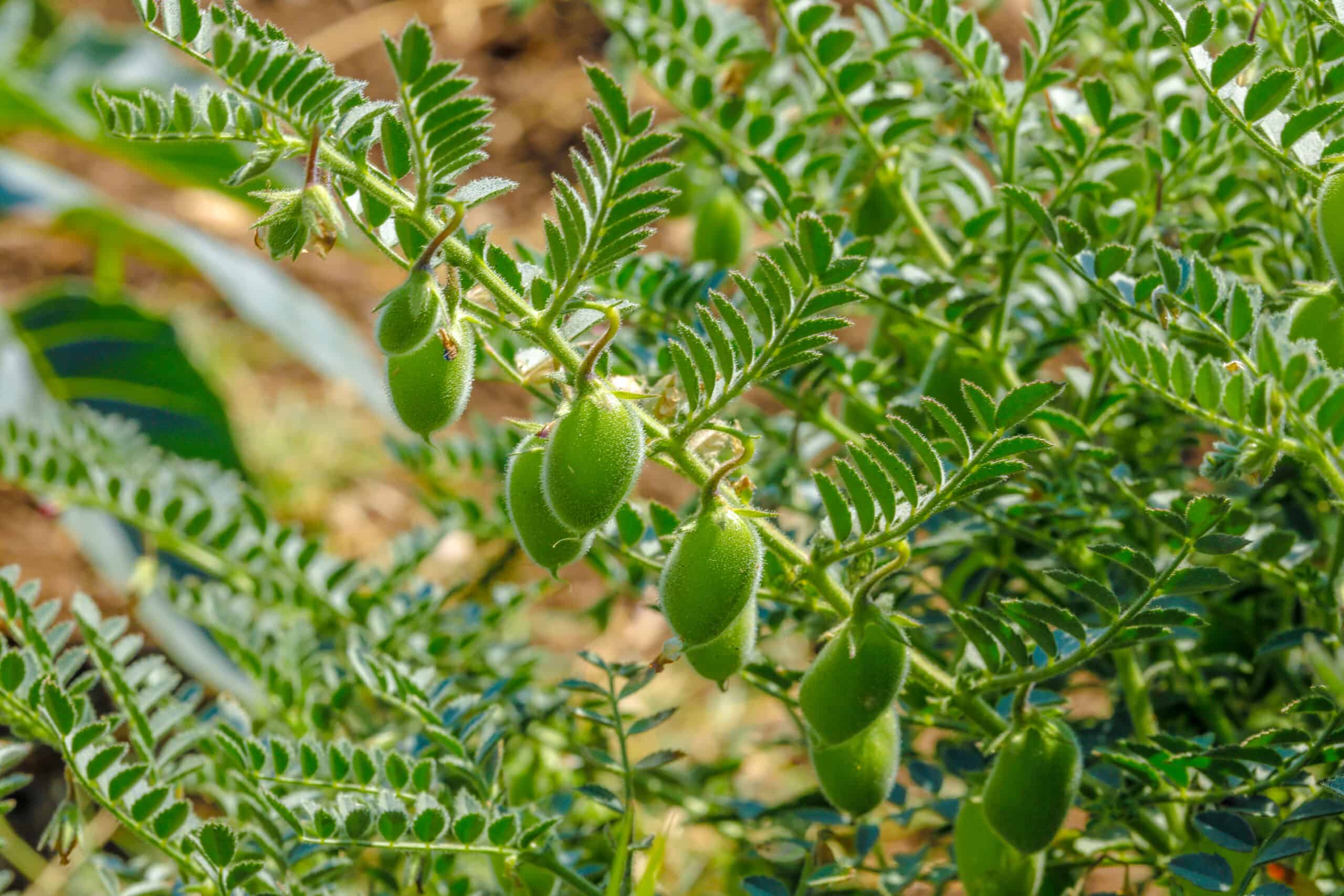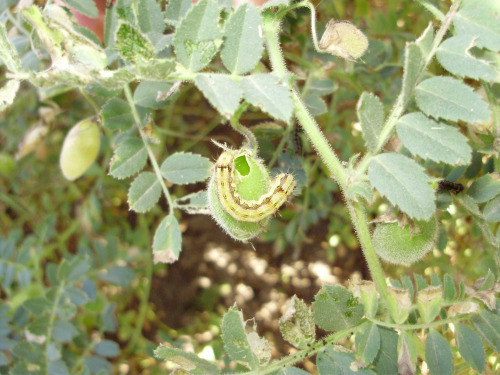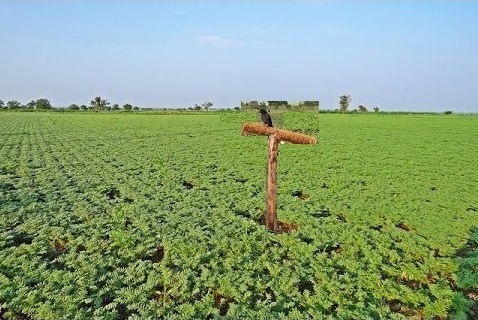
The Complete Guide of Gram Pod Borer Management to improve the yield and quality of Chickpea crop
- By Agrosiaa Admin --
- Feb 13, 2021--
India is the single largest producer of Chickpea in the world, accounting for 65% (9.075 million tonnes) of the total production under Chickpea. All Chickpea growers face a major problem of Gram pod borer that damages almost all the pods in case of severe damage, but causes nearly 20-30% annual yield losses in India. To avoid this, we should be aware and use integrated pest management to save on crop protection costs by identifying pests.

A HEALTHY CHICKPEA CROP
Do you know?
The larvae are known by various names such as American bollworm, Green bollworm, Gram pod borer and Pigeonpea pod borer.
First of all let's learn its nature of damage!
- The female moth lays 150 to 300 round glossy greenish yellow eggs on the leaves, buds, buds and flowers. These eggs look like poppy seeds. The larvae hatch in 2 to 3 days.
- When the crop is 3 weeks old, small larva appear on it. These small larva scrap the leaves. As a result, the leaves turn yellowish white, dry out and fall off.

GRAM POD BORER FEEDING ON LEAVES
- The fully developed gram pod borer is of parrot color (as well as a variety of hues) and has dull gray lines on the sides of the body.
- Large larvae feed on whole leaves and stalks. So only the branches remain on the plant
- In crop flowering stage the intensity of pest damage increases. Grown gram pod borer feeds on buds and flowers.
- In full grown stage, the mouth of borer is gutted into pod and feed the inner grains.

GRAM POD BORER FEEDING ON PODS
- One larva usually damages 30-40 pods. Larval infestation is seen more especially when the crop is in the inflorescence stage.
How can you save your gram crop from losses?
Integrated pest management should be adopted to save your Chickpea crop from pod borer.
Before sowing and during sowing
- Before sowing, deep ploughing should be done in summer so that the insect pupae are picked up by the birds and eaten, as well as die due to sun rays.
- Taking intercrops like wheat, lentils, mustard or linseed helps in reducing the incidence of gram pod borer. In gram crop, intercrop or mixed crop or two rows of linseed, coriander or mustard around the field is used for breeding of predatory insects. Natural enemy of pests and the friends of the farmer are working to control the pod borer on the crop and they are indirectly controlling the pod borer through their livelihood.
- Sow the crop at the right time and at the right distance.
- When sowing gram, mix sorghum seeds mixed with 100 gm per hectare. It is used as a bird perches.
- Millet, Sorghum, Maize or Groundnut should be rotated in the field where gram pod borer are particularly prevalent.
Crop growth stage
- The crop should be kept weed free by weeding before the crop is 1 month old.
- Remove and destroy weeds like wild okra, Petari on the dam.
- When the crop is one month old, plant 8 T shaped bird stands per acre 1 to 1.5 feet higher than the crop. Natural host insects such as Chrysopa, Lady Bird Beetle and Reduvhida bug as well as predators of borer e.g. Heron, Myna, Parrot, Nilkanth, Black sparrow etc. control the crop by picking up the larvae. Bird perches have to be set up in the fields to make picking their larvae easier. However, if sprayed with pesticides, they will not come to the fields due to the smell of pesticides.
- Plant 4-5 pheromone traps per acre at a height of 1 m from the ground. If 8-10 moths are found in this trap for 2 to 3 consecutive days, the number of pheromone traps should be 8 to 10 per acre.
- Put a line of marigold crop around the main crop.

Bird stand erected to control gram pod borer in Chickpea crop
Flowering and grain filling stage of crop
- Large larvae on the crop should be picked up and eradicated.
- In case of insect infestation by the farmers by monitoring the crop or after 40 to 50 per cent of the crop has reached flowering, the first priority should be given to botanicals or biological pesticides. In the initial period take one spray of Neem extract 5 per cent or Azadirachtin 300 ppm @ 50 ml per 10 litters of water. As a result, the larvae lose their appetite and die.
- If relative humidity is sufficient, spray Baeuveria bassiana at the rate of 60 gm per 10 liters of water. This will help control the larvae without harming their natural enemies.
- Use recommended chemical pesticides if the larvae reach the economic threshold level (average 1 to 2 larvae per meter row or 5 per cent loss of pods or 8-10 moths per pheromone trap continuously for 2-3 days); Otherwise spray should be avoided. Spraying after reaching the above incidence level will reduce the cost of spraying by avoiding a reduction in your production.
- Mix any one of the following pesticides in 10 litters of water and spray with a simple (knapsack) pump. If you want to spray with power pump, triple the amount of pesticides. The first spray should be done after 40 to 50 per cent flowering and the second spray after 15 days.
- Quinolphos 25% EC @ 20 ml
- Imamamectin benzoate 5% SG @ 3 g
- Deltamethrin 2.8% EC @ 10 ml
- Lambda cyhalothrin 5% EC @ 10 ml
- Chlorantraniliprole 18.5% EC @ 2.5 ml
- formothion 25%EC @ 20 ml
- Fenvalerate 20% EC @ 5 ml
- Cypermethrin 25% EC @ 8 ml
- Fosalone 35% EC @ 14 ml
- Renaxipyre 20% SC @ 2.5 ml
- Flubendamide 20% WDG @ 5 g
- Chlorpyrifos 20% EC @ 25 ml
6. Deep ploughing of the soil to destroy dormant insects after harvest.
Conclusion
Farmer friends, it is necessary to control the ghat larvae to get better yield of gram crop in this rabi season. For this, we should take care of the following important things.
- Cereal or millet crops should be taken along with gram crop for crop rotation.
- Deep ploughing of the soil should do.
- Install 4-5 pheromone traps and 8 bird perches per acre.
- Biological control is very effective when there are first and second stage of larvae in the field.
- Recommended chemical pesticides should be used during high incidence.
So friends, we learned about a problem with the Chickpea crop. Now we will see in the next article how to properly plan irrigation management on water availability for more and quality production of Chickpea crop.
Stay with this friend of yours. See you soon.
Ram Ram!










IMPORTANT LINKS
http://krishi.maharashtra.gov.in/Site/Upload/Pdf/PMFBY__2020_Gr_for_publication.pdf
http://krishi.maharashtra.gov.in/Site/Upload/Pdf/PMFBY_Process_Leaflet_Final_Print_File_15-10-2020.pdf